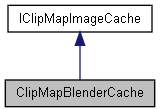ClipMapBlenderCache Class Reference#include <clipMapBlenderCache.h>
Inheritance diagram for ClipMapBlenderCache: 
Constructor & Destructor Documentation
Member Function DocumentationInitialize the image cache that can hold at least clipMapSize*clipMapSize pixels of data. In general the image cache will allocate a bit more than that so it can be efficient in pre-empting requests. The image cache will also store mipmap data for the interest point, at least clipMapSize px at each miplevel. e.g., for a parameter of 512, we would have available in the cache at all times 512*512*clipMapDepth pixels. Ideally, we would ensure at least one page quanta's worth of extra data is present at all levels so we can fulfill new data requests quickly. For instance, if we have 128px paged tiles, we'd want to have at least 512/128 = 4 base tiles and 2 border tiles on each axis, so 36 loaded tiles at all times at the source level of detail. This is about two and a quarter megabytes of data per clipmap level, so a cache of about 7 levels * 2.25mb = 15.75mb in system memory for a 32k px source texture. We don't need any "mip" levels - just pure source data for every cliplevel greater than or equal to the clipmap size. As we may need to regenerate the full clipmap in the case of zombification, we can't discard the top level of data, even though it is never needed in the course of normal clipmap operation. Implements IClipMapImageCache. Indicate our interest area center. The cache is for a fixed size area, so we disallow changing that area size. Implements IClipMapImageCache.
Indicate that we are going to be updating a series of rectangles on specified level of the clipstack.
Implements IClipMapImageCache.
Indicate that we're updating a specific rectangle on a clipstack.
Implements IClipMapImageCache.
And finally, give the cache a chance to finish processing for a specified clipstack level.
Implements IClipMapImageCache.
If true, we'll allocate render targets rather than normal diffuse maps.
Implements IClipMapImageCache.
Generate appropriate volatile geometry and set it as the current VB.
Member Data DocumentationReferences to image source for opacity and lightmap information.
Used for streaming video data to card for blend operations.
Whether LM1 (lightmap blend factor 1) shaders should be used.
Whether mOpacityScratchTexturesFF should be used, amongst other things.
Shared shader constant blocks.
SM2.0 shader used for one pass blending.
SM1.0 shaders used for two pass blending.
FF.
Images that we're blending; in channel-usage order.
|
|||||||||||||||||||||||||||||||||||||||||||||||||||||||||||||||||||||||||||||||||||||||||||||||||||||||||||||||||||||||||||||||||||||||||||||||||||||||||||||||||||||||||||||||||||||||||||||||||||||||||||||||||||||||||||||||||||||||||||||||||||||||||||||||||||||||||||||||||||||||||||||||||||